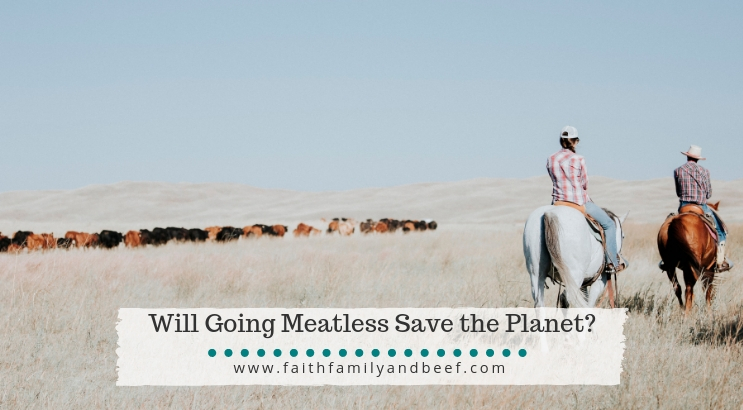“I’m going to cut the amount of meat in my diet because I just really want to be more environmentally sustainable.”
I’ve seen and heard the above statement quite a bit recently. Folks are considering adopting a meatless, or at least reduced-meat, diet out of deep and genuine concern for the well-being of the environment.
And I get it.
I 100 percent understand the concern. I want to be more sustainable, too. I have a deep and genuine concern for the well-being of our environment, too. My concern, however, is not what happens if we keep eating meat. But rather, what happens if we stop.
I honestly fear what our world would look like without meat because last time I checked, beef was meat. And not only is beef my family’s livelihood, but also, I legit fear the unintended consequences our environment would suffer if we all cut beef out of our diet.
Saving the Sandhills.
Cattle literally saved these Sandhills that I call home.
True story.
The Nebraska Sandhills are one of God’s great wonders and are truly a thing of beauty. What was once a barren desert made up of 20,000 square miles of sand dunes, is now a unique ecosystem that is home to a countless number of plant and wildlife species. This diverse and fragile landscape is thriving now because of the cattle that graze these hills, the impact they make, and the people who manage them.
Would grass grow in the Sandhills without cattle to graze it? Sure – but not for long.
Standing grass blocks sunlight hindering new plant growth. When cattle graze a pasture, they eat the more tender grasses and trample some of the less tender grass and plants into the ground. As the cattle graze and trample, they produce digested plant matter (more commonly known as poop). The combination of the grazing, trampling and pooping fertilizes and secures the soil, retains moisture, promotes healthy plant growth, and prevents erosion.
As ranchers, we don’t just let our cattle graze all willy-nilly wherever they want, whenever they want. Nope. Each year, we come up with a grazing plan, that serves as a guide on where and when we should graze certain pastures. We’re real original with naming – we know.
Anyway, the grazing plan is based on the nutritional needs of the herd, time of year, observations we’ve made during the previous year, and which pastures could stand to have a little more litter (more about litter HERE). Strategic grazing (and littering) helps us protect and preserve the Sandhills’ resources and beauty, ensuring we will be raising cattle far into the future.
Cattle are upcyclers.
Like the majority of grazing land, the Sandhills are unarable. “Unarable” means that they are not suitable for growing any sort of fruit and veg a human would want to eat let alone digest. It’s super hilly here (as the name suggests), our growing season is insanely short, and the soil (and by “soil” I mean sand) isn’t great at holding water and the nutrients needed to grow things people like to eat. So, not great for farming.
Trust me, I’ve tried gardening in the sand. It doesn’t work very well.
These hills, however, are great for growing grass (provided there are cattle here, see above). And cattle eat the grass and turn it into a something we can eat – beef. They can do this because they have a four-chambered stomach. The largest chamber is the rumen, which helps them get the nutrients they need from plants, and part of plants, that humans don’t eat or can’t digest.
In other words, they upcycle.
And, their upcycling superpower is not limited to grass. They can turn all kinds of things we can’t eat into delicious, nutritious beef – things like beet pulp from making sugar and distillers grains from brewing or ethanol production. They can also more efficiently use the nutrients within a kernel of corn than we can, but that may be a story for another time.
The point is that cattle have the unique ability to turn something that would otherwise be waste into something that tastes great and we can actually eat. That’s pretty impressive and insanely sustainable, if you ask me.
The fact of the matter
Now, I’m not here to tell you what to eat or what not to eat. I’m not even saying we can’t do more to improve the way we raise beef and become even more sustainable. We can. And we are working on it, constantly. But what I am saying is that going meatless is not going to save the environment or make even the slightest positive impact.
It would be a detriment to the environment.
The truth is that everything we do as humans impacts the environment. And if we really want to become more sustainable, the greatest impact we can make is reducing waste, specifically food waste.
We waste a staggering amount of food each year. It’s truly embarrassing. And it’s something everyone, myself included, could stand to improve upon. If we want to save the environment, we need to start there.
For the sake of brevity, I kept this short(ish). But this is a subject I could go on and on about. So, if you have questions that weren’t addressed here or would like more clarification, please feel free to reach out. I’m here and I’m happy to help! 🙂


 Hello! I’m Terryn – the wife, mother, food safety enthusiast, Stormy Kromer fanatic who has slightly (okay, a lot) random tendencies, dabbles in photography, and shares (maybe a little too much) here at FFB.
Hello! I’m Terryn – the wife, mother, food safety enthusiast, Stormy Kromer fanatic who has slightly (okay, a lot) random tendencies, dabbles in photography, and shares (maybe a little too much) here at FFB.